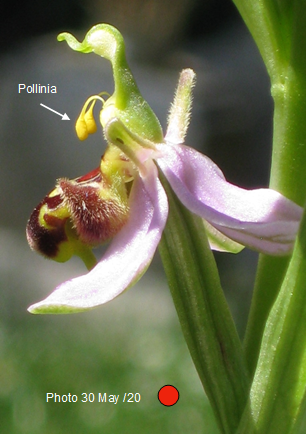
By June 8th 2020 Bee Orchids were flowering on eight of the sites shown on last winter’s plan - and the flower-count was growing daily. The colour spots identify where each photo was taken. The grassy area that gets the most sunshine produced the most flowers.
 It was one, single petal of the orchid flower that evolved to mimic the shape of a female bee. The two other petals changed to look like a bee’s antennae. The pink three-petalled “flower” that the fake “bee” is sitting on evolved from its three green sepals.
It was one, single petal of the orchid flower that evolved to mimic the shape of a female bee. The two other petals changed to look like a bee’s antennae. The pink three-petalled “flower” that the fake “bee” is sitting on evolved from its three green sepals.
Close to where people walk, three sites are empty. But trampled orchids have usually reappeared in the following November.
These are wild flowers. They choose to grow close to us. Their exquisite beauty should be caged as little as possible.
On this site, (see above) seven flowers are already open on four flowering stems. Other sites all have just one orchid. Did four times as many seeds really fall on this one site in the last fourteen years?
 In pre-historic times there must have been huge advantages for orchids to go to such lengths to trick male bees into transporting their pollen. It must have taken millenia for petals to evolve to look like a female bee.
In pre-historic times there must have been huge advantages for orchids to go to such lengths to trick male bees into transporting their pollen. It must have taken millenia for petals to evolve to look like a female bee.
But today, these two yellow pollinia more often than not pollinate Bee Orchids without any insects at all.
Long Green Seed pods can be seen swelling under each flower ready to disperse seeds - by the thousand.
Last year the plants were contorted by aphids. Instead of insecticide an artists brush, dipped in weak detergent is being used to paint these off regularly each year.
Our project aims to discover if our orchids will multiply in 2021 not by seed but, for example by rhizomes underground. So to be certain, all seedpods will be removed in July.
